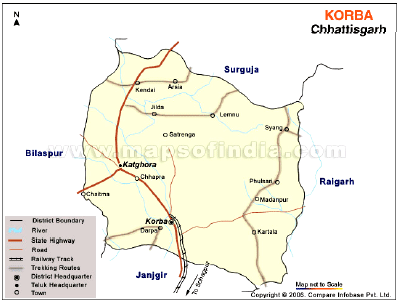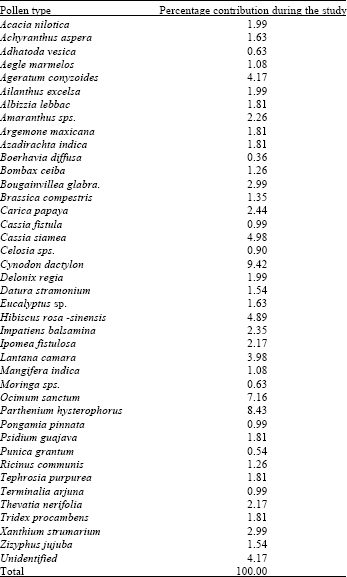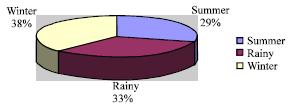Research Article
A Quantitative Survey of Pollen Flora in Atmosphere of Korba-Chhattisgarh, India
Department of Botany, Kamla Nehru College, Korba, India
LiveDNA: 91.24318
R.V. Shukla
Department of Botany, C.M.D., P.G. College, Bilaspur, India
In the bioassay one can use presence/absence/ abundance/distribution/morphology and biochemical characteristics of bio-particles to arrive at a conclusion regarding air quality of that area. There are plants and animal groups including human being are sensitive to the air particles, which can be monitored through proper quantification and standardization of habitat responses and sensitivity in biological species. In this concern the study on airborne biological materials, mainly fungal spores and pollens and their impact on biological species is an important aspect. Jacobs (1951) elaborated the term to include dispersion of air borne insect populations, fungal spores, pollen and bacteria. Since, pollen have long been known as one of the important environmental bio-particles causing dermatitis, respiratory and cardiac diseases along with allergic manifestation in human beings. Therefore, a preliminary study on air borne pollen has been conducted in Korba town, which is one of the biggest industrial towns in the country.
The biopollutants in developing countries like India causing various health hazard to life of great concern for environmentalist. Connection between the occurrences of air borne allergy symptoms has been established by the elution of protein antigen in contact with mucous surface. Pollen grain gain entry in to the respiratory tract of warm blooded animals with the rhythmical inhalation of the air through nostrils. Size, Shape and surface structure of air borne pollen are important factor in the inhalation, retention and exhalation of man. The air almost always contains pollen, but their number and types depends on the time of days, weather, season and geographical location (Wadhwani, 1994).
In Korba, there are many thermal power plants, explosive industries and numerous open and underground coal mines along with aluminum plant. This is one of the biggest energy capital in India which is indeed, unequally placed as for as its study on biological index is concern. In industrial development more than 95% of primary vegetation has been destroyed. Knowingly that plant species can accumulate industrial pollutants in a big way no study has been carried out on the relationship between the industrial units and the destruction of habitat loss. In hydrophobic system of more than 20 km radius of Korba, except the human population, no other groups either of decomposer /consumer/producer could achieve a significant number over the land surface for their identity. Since, the living organisms can serve as excellent quantitative as well as qualitative indices of the pollution of the environment therefore, it is essential to establish a scientific basis for the systematic approach to catalogue the pollen diversity related with human health (Sandeep and Shukla, 2010).
The pollen is the most vital part of the flowering plant with a special structure and function. Pollen grains are produced in anther, the male reproductive parts of flowering plants. They carry the genetic material from one generation to other and are, thus, important entities in the biological cycle of flowering plant (Nayar, 1990). The presence of pollen grains in the atmosphere in different geographical region differ depending on pollination seasons and air borne pollen grain concentration (Romano, 1988). The air borne pollen grains are well known to cause allergic symptoms in susceptible individuals. Allergic response to hay fever and pollinosis are generally recognized as the most prevalent and important of all allergies . The study of air borne pollen have gained significant importance in recent years because of it’s application on the diagnoses and treatment of patients suffering from allergic disorders caused by the pollen.
Work on pollen allergy started in 1766 when Koelreuter reported dissemination of pollen by wind. Blackley (1873) of Manchester established that pollen is an important factor in causation of hey fever. Pollen flora have been prepared exhaustively or in part of countries. Pollen flora of India though at present appears a distant dream to be realized, isolated region based attempts have, however, been made of angiosperm taxa for the Himalayan region (Gupta and Sharma, 1986), Upper Gangetic plain and South India Hills (Vasanthy, 1976).
Mandal et al. (2006) studied current status of air borne pollen grains in Kolkata. Mangala et al. (2006) studied pollen of Miramar beach area-Goa. Pandey et al. (2005) have done a preliminary study on atmospheric pollen flora at Atarra. Satheesh et al. (1993) studied incidence of air borne pollen in the atmosphere of Tiruchirapalli. Singh et al. (1993) have done a volumetric survey of air borne pollen allergens in Delhi. Sudha and Agashe (1996) published a report on seasonal periodicity of pollen grains in Banglore. Qureshi et al. (2002) done a palynological study of genus Tragopogan in Pakistan. Noor et al. (2004) studied pollen grains of cultivated plants of University of arid agriculture Rawalpindi. Kheiri et al. (2006) studied morphology of species Verbasum. Many other workers like Giorato et al. (2000), Villegas and Nolla (2001), Mishra et al. (2002), Murray et al. (2002), Paloma et al. (2004), Husnain et al. (2005), Tejera and Beri (2005), have also done significant work on palynology.
Objective of present study is to study the biotic particles present in the atmosphere especially pollen grains, their identification, preparation of pollen calendar of the town and study pollen in relation to human health. Therefore, a preliminary study on air borne pollen has been conducted in Korba town, which is one of the biggest industrial towns in the country.
Korba is the industrial hub and power capital of Chhattisagrh state was accorded the status of a full-fledged revenue district on 25th May 1998 covering an area of 7,14,544 ha and located an altitude of 304.8 m above sea level. Korba experiences a hot, arid temperate climate and receives an average 1506.7 mm rainfall annually. Korba is situated in the north of Chhattisgarh and lies at 22° 01’-23°01’ latitude and 82°08’-83° 09’ longitude. It is surrounded by Ambikapur distt. in North, Raigarh distt. In east, Janjgir distt. in south and Bilaspur distt. in West (www.korba.gov.in).
Korba is the biggest industrial town. This is one of the most polluted cities of India (Fig. 1).
During present investigation an extensive survey was conducted for the air sampling particularly in a center place (Transport Nagar) of Korba town. The seasonal air sampling was carried out at the height of 20 feet above the ground level for a period of one year i.e., from March 2007 to February 2008.
The samples of pollen were taken fortnightly using Rotorod air sampler (Giri and Saoji, 1996). The Vaseline coated slides were exposed 10 AM to 6 PM (Every one hour the sampler was switched off for 15 min). After sampling the slides were mounted with glycerin-jelly and scanned under microscope (400 X). Identification of the pollen was done on the basis of reference slides prepared of local flora and with the help of available literature (Nayar, 1990).
The conversion factor of this sampler is 5. Hence, if the total number of one pollen type from the catches is 14, then total number of these pollen types per meter of the air is 14x5 = 70 (Tilak, 1982). This number is the total number of pollen m3 of the air at that particular site and height at that time.
The air borne pollen of a particular region is influenced by topography and meteorological parameter of the concerned area. A total 40 different pollen types (Table 1) have been identified during the study in which Ailenthus, Carica, Datura and Parthenium are reported human allergens.
 | |
| Fig. 1: | Map of study area (Source: www.mapsofindia.com) |
The yearly total No. of pollen was found 5515 m3 during the March 07 to Feb. 08. The dominant pollen were of Cynodon dactylon. (9.42%) due to it’s presence of through out the year, followed by Parthenium hysterophorus. (8.34%), Ocimum sanctum (7.13%) and Casia siamea (4.98%). For the year Novembert ’07 is the month of highest incidence 685 m3 (12.42%) of pollen (Fig. 2) and the minimum number of pollen were observed during the month of June 2007 and February’ 08 with 265 m3 (4.80%) of pollen. Figure 3-6 shows month wise contribution and seasonal variation (in term of No. of pollen) of four major pollen contributors during the study i.e., Cynodon dactylon., followed by Parthenium hysterophorus, Ocimum sanctum and Casia siamea.
Figure 3 shows seasonal variation of Cynodon dactylon. Cynodon dactylon found throughout the year with max in November 07 and min in June 07. Figure 4 shows seasonal variation of Parthenium hysterophorus. Parthenium hysterophorus found max in August 07 and absent in April, May and June 07. Figure 5 shows seasonal variation of Ocimum. Ocimum found throughout the year with max in April 07 and min in Feb. 08. Figure 6 shows seasonal variation of Casia siamea. Casia siamea found max in March 07 and absent in June to October 07. These all figures show great variation of presence of pollen in atmosphere. Figure 7 shows some months of higher pollen incidence whereas, Fig. 8 shows seasonal variation and their percentage contribution on total pollen count.
| Table 1: | Air borne pollen and their percentage contribution during March 2007-Feb. 2008 |
 | |
 | |
| Fig. 2: | Monthly % contribution of pollen in air Month |
 | |
| Fig. 3: | Major pollen (in number) contributors during the Mar. 2007-Feb. 2008 Cynodon dactylon |
 | |
| Fig. 4: | Major pollen (in number) contributors during the Mar. 2007-Feb. 2008 Parthenium hyasterophorus |
 | |
| Fig. 5: | Major pollen (in number) contributors during the Mar. 2007-Feb. 2008 Ocimum sanctum |
In previous study, Mandal et al. (2006) reported 32 pollen types where Trema orientalis (21.75%) was dominant. Maximum pollen incidence found in July and May whereas, lowest in December. Mangala et al. (2006) reported 20 varieties of pollen grains were Poaceae family is dominant, present study also justify that. Pandey et al. (2005) reported 79 pollen type where gamopetalae contribute max. pollen (42.70%).
 | |
| Fig. 6: | Major Pollen (in number) contribututors during the Mar. 2007-Feb. 2008 Cassia siamea |
 | |
| Fig. 7: | Some months of higher pollen concentration |
 | |
| Fig. 8: | Seasonal variation of pollen count |
Satheesh et al. (1993) reported 52 different types of pollen where, September 1987 is the month of highest incidence and June and May 1987 and 1988, respectively are the month of lowest incidence. As usual Poaceae family contributes max. pollen whereas, Nov. is the month of higher incidence in the present study. Singh et al. (1993) identified 112 pollen type from atmosphere of Delhi where, August (3007 m3) is the month of highest incidence during the study of 1985-86. During the study of year 1986-87 January (5539 m3) is the month of highest incidence. In other hand February (149 m3) is the month of lowest incidence during the 1986-87 and June (251 m3) is the month of lowest incidence during 1985-86. This two years result are quite contradictory. Sudha and Agashe (1996) reported 91 pollen types from Banglore where October and November are the month of max. incidence and Casuarina was the major contributor. From Southern India Agashe et al. (1983) reported Parthenium, Casuarina, Cheno/Amaranth, Cocos nucifera, Ricinus communis and grasses to be dominant pollen types from the atmosphere of Banglore. Alwadie (2008) reported 50 pollen types from atmosphere of Abha city where Poaceae (55.1%) family contributes max. pollen, July was the month of highest incidence where Feb. was the month of min. incidence. In our study also Poaceae is the main contributor and Feb. is the month of min. incidence thus, the present study support the view of Alwadie (2008). Frenz (2000) demonstrated that airborne pollen concentrations exhibit spatial variability, as pollen from nearby vegetation exerts a profound local influence. High incidence of Cynodon (Poaceae) probably due to the presence of a large area of such vegetation and grass loan, in and around sampling site. Rainfall and relative humidity yielded negative correlation since water droplets wash away pollen particles (Vega-Maray, 2003).
These all result of previous studies show that occurrence and distribution of pollen in the atmosphere is variable, it’s depend on meteorological factor, vegetation type and geography of particular place. Each result mentioned above contradicts to other. So, we are unable to predict the air borne pollen of a particular place on the basis of previous study.
Parthenium hysterophorus, an ubiquitos, amphiphilous weed has extensively encroached in and around Korba, accounted for high prevalence in the atmosphere.
Since, there are changes in meteorological conditions each year therefore present investigation of one year is not sufficient to analyze air-borne pollen with that of trends of seasonal variation. The annual variation of pollen grains provides important information for effectiveness of immunotherapy to a particular allergen. The present study provides information on the quantitative composition of pollen grains present in the atmosphere of Korba during 2007-08. Among the all pollen types, grasses (Poaceae) are the main contributor to the total pollen concentration. High concentration of Poaceae pollen is also reported from other part of the country.
The atmospheric pollen concentration differs not only during the different season but also during the same day. These variations are regulated by various climatic factor like temperature, relative humidity, rainfall, wind velocity (Singh et al., 1993) and also by flowering period, because flowering period is also changes according to the climatic factor. The pollen grains were show highest incidence during the November probably due to most of the anemophilous plants flower at that time and librates large number of pollen in the air.
The present study is of one year provides a preliminary information on different pollen types. The regular monitoring of pollen may provide better knowledge for specific pollen causing various types of heath disorder and allergy in human being. Therefore, it necessitates carrying out regular air monitoring of bio-particles in Korba which is almost environmentally sick.
The first author is grateful to the University grants Commission, CRO, Bhopal for financial support during the study. R.V. Shukla (co-author) helped to identify the pollen grains and in deciding of the methodology.